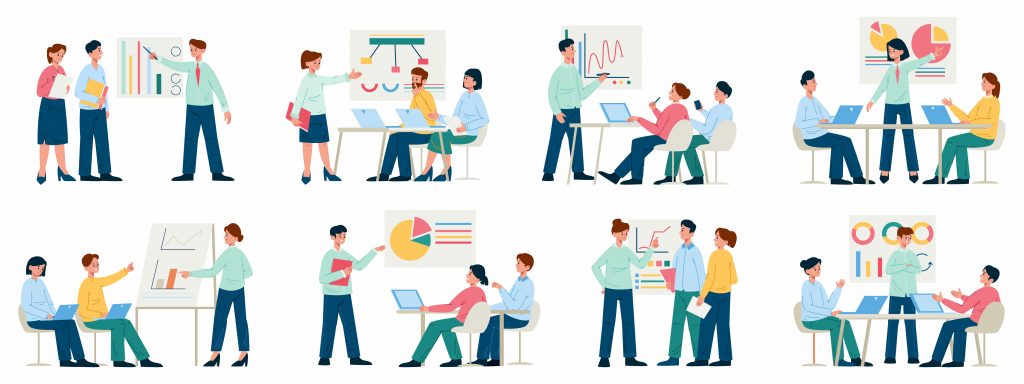Unsurprisingly, presentations are a commonly dreaded method of communication, but it’s just a case of understanding the basics and putting them into practice.

- 1. Qualities of Great Presentations
- 2. Worries When Giving presentations
- 3. Delivering an Effective Presentation
- Keep Presentations simple
- Start Strong
- Create an Easy-To-Follow Structure
- Use Visuals in Presentations
- Use Simple and Effective Slide Design
- Tell Stories During Presentations
- Tailor it to Your Audience.
- Practice and Prepare Presentations
- Be Passionate About the Topic
- Take A Breath and Slow Things Down
- Use a Remote
- Have Backup Material
- Be Yourself
- Finish Presentations on a High
Presentations are the default communication tool in the business world; more than 25% of people see at least one presentation daily. Nevertheless, if the thought of delivering a presentation gives you nightmares, don’t worry; that’s completely normal. Public speaking may seem daunting, but there are many strategies you can use to deliver a successful and engaging presentation.
“You can have brilliant ideas, but if you can’t get them across, your ideas won’t get you anywhere.”
Lee Iacocca
Good presentations start with the content. It doesn’t matter what your message is; if it can’t be communicated, it just won’t work. Every audience is different, but if you research your topic and practice, practice, practice, you will connect with them successfully.
1. Qualities of Great Presentations
Some of the things that audiences appreciate in a presentation are:
- Relevant content and well-organised content
- Creativity
- Audience involvement
- Relevant examples
- Time for questions
- Reasonable duration
- Interesting visuals
- Humour
- Clear and understandable language
2. Worries When Giving presentations
The most common worries people have in business presentations include the following:
- Not being able to speak.
- Forgetting your subject matter.
- Having a heckler or know-it-all in the audience.
- Having people notice your anxiety.
- Not being able to answer an audience question.
But these concerns are all surmountable! The more presentations you deliver, the more you will know how to handle these issues.
3. Delivering an Effective Presentation

If you want to get your message across with impact, remember that how you deliver your presentation is as important as its content. Here are some tips to help with your next presentation and hopefully eliminate stress. Using these strategies, the audience will fully engage and leave positively, not feeling they have just endured another ‘Death by PowerPoint’.
Keep Presentations simple
Your presentation’s ideas must be accessible and easy to follow; simplicity is vital. Less is more, and you should try to keep the amount of text on any slide to an absolute minimum. Ensure you are clear on the key information you want people to take away. Keep your main ideas to three or fewer points, and repeat these at the start and end of your presentation so that your audience remembers the most important message.
Start Strong
A strong beginning draws people in, just as in a book or movie and a solid, entertaining opening makes it much more likely that your presentation will be well-received. Some ways to achieve this include:
- Showing a video as the introduction to your presentation
- Making a statement that surprises your audience
- Posing an interesting question or problem
- Using an interesting or thought-provoking quote
- Having an unexpected statistic or image.
Remember, again, that whatever you use to start your presentation needs to be relevant and support the core message you are trying to convey.
Create an Easy-To-Follow Structure
A logical, easy-to-follow structure seems obvious, but we sometimes lose this when putting a presentation together. Try to put yourself in the position of an audience member who knows little or nothing about the subject. Make sure there is an organised flow and logic to the presentation. The best and simplest structure is to break your presentation into three sections: an introduction, a body, and a conclusion.
- Introduction – states your core message and explain why it’s useful or relevant to your audience.
- Main body – provides the facts, quotes, and evidence to back up your main points.
- Conclusion – reiterates your core message and tells the audience how they can put into practice what they’ve just learned.
Remember to be brutal with your material. Cut everything you don’t need and rearrange the presentation’s structure if necessary.
Use Visuals in Presentations

Integrating colours, images, graphs, video clips, photographs and infographics will add life to your presentation. If concepts can be better supported or explained using a visual aid, then use them in your presentation. You can often use a visual instead of a block of text. But don’t overload your slides with visuals or use them if they are irrelevant. Simplicity is key; if visuals make things more complex, leave them out. And, as a rule of thumb, avoid animations in slides.
Use Simple and Effective Slide Design
Good slide design can distinguish between a good presentation and one that fails. Simple considerations will improve your design:
- Use colour sparingly and stick with one or two colours, so your presentation has a consistent look and feel.
- Font consistently is key! Don’t switch between caps and lowercase. Stick with one font and size throughout your slide deck, although you can vary the size (sparingly) for emphasis.
- Take time to format. Ensure your text is aligned and neat and that images are placed and spaced appropriately. And once again, keep it simple.
Tell Stories During Presentations
Telling a life story or some other anecdote makes you more relatable. Your audience will feel more connected and comfortable with you. This will also have the benefit of making you feel more relaxed. Stories add context and help the audience understand the points in the presentation, but ensure you only tell stories that support your main ideas.
Tailor it to Your Audience.
What do you know about your audience? The more you know, the better. What is their level of knowledge on the subject? Are they interested or involved in it? The key to landing a successful presentation is knowing ‘What’s In It For Them’. Many presenters seem to forget that the presentation is for the audience. It is not to showcase the presenter. Put your audience first, middle and last in everything when preparing your material.
Practice and Prepare Presentations
Practising a presentation may not be the most natural thing, but it is very helpful. You can try running through the presentation in front of a mirror or a small audience. Ask for honest feedback and take any comments on the board positively.
Try to run through the presentation a few times, at least once in the space where you will deliver it, if possible. Knowing the structure and content of the material will significantly benefit the delivery. Don’t try to memorise your speech verbatim, however. It is very easy to get hung up on getting a presentation word-for-word perfect, and forgetting something can throw you off track. Practice, as with everything, will make your presentation better.
Did you know that Steve Jobs used to take two days to prepare a 20-minute presentation?
Be Passionate About the Topic

Suppose you show you are genuinely excited about the subject and display your interest. In that case, this will engage the audience and capture their attention. People like to listen to presenters who are excited about sharing their knowledge.
Maintaining eye contact during your delivery also strengthens your connection with the audience. And smile. It will go a long, long way.
Take A Breath and Slow Things Down
When we are nervous, we tend to rush. If this happens, pause, take a breath and force yourself to go slower. It’s far better to go slower and take more time to get across everything you want to instead of leaving your audience more confused.
Be honest and authentic during your delivery, and be conversational with your audience. Always talk “to” your audience instead of “at” them.
Use a Remote
Using a remote will mean you can face the audience and not have to keep returning to your laptop to advance slides. It also helps you keep control of the pace of delivery.
Have Backup Material
You may need to fill in extra time or an activity if equipment goes wrong. You may find that your audience already knows some of the things you were going to tell them or that the material is irrelevant. Always prepare something extra to fall back on. Preparing for all eventualities will help soothe your nerves and allow you to feel more in control.
Be Yourself
People will quickly spot a lack of authenticity. Don’t attempt to impress the audience or be something you are not. Get the point across as you see it, simply and honestly. That is the whole point of the presentation.
If you can, use humour. Telling a funny story really makes a presentation work. It makes people remember your message, but if that’s not you or it is not working, then avoid this.
Finish Presentations on a High

Wrap up your presentation by focusing on the feeling you want the audience to take home.
“They might forget what you said, but they’ll never forget the way they made you feel”
Maya Angelou
If there is a message you want the audience to remember, then say it slowly and leave a pause at the end. Silence and pauses are much more powerful than you realise and make what you have said meaningful.
Also, using a call-to-action ends your presentation with strength and impact. Let your audience know precisely what you want them to do next.
Infero offers an Effective Presentations course that covers all you need to know to help you give the best presentations possible. For more tips and tricks on presentations, look at our blogs below!
6 Presentation Types: Choose the Best to Increase Success | (inferogroup.co.uk)
Why Presentation Skills Are THE Number One Soft Skill | (inferogroup.co.uk)






